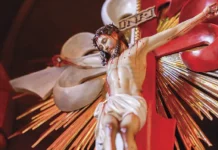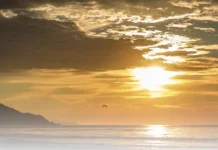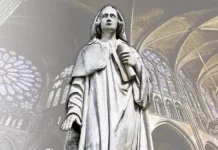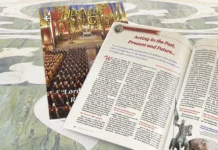Over two centuries ago, a beautiful and merciful Queen established a palace in an almost inaccessible gorge. What mysterious fascination draws thousands of pilgrims there every year?
Perched in the air and gracefully balanced between two mountains, the Basilica of Our Lady of Las Lajas seems to defy the laws of physics. In this place, pilgrims can hear the harmonious melodies of the serene natural setting, inviting them to contemplate one of the most sublime wonders of creation.
Hovering above a riverbed, the construction reminds us of the ancient medieval cathedrals built of stones and crowned with spires ascending to Heaven in prayer. The numerous statues of Angels and Saints set among the columns and arches of the façade seem to introduce us into an atmosphere at once grandiose and filial, proper to a meeting with a queen.
Inside, the tall, slender columns, crowned with Gothic vaults, trace a solemn procession leading to the apse of the church. However, this sanctuary has a unique attribute which adds even further to its beauty and mystique: its presbytery is adorned, not with splendid stained-glass windows or paintings, but with the simplicity of stone slab, for the church is nestled in the mountain, as if serving as a frame for a treasure hidden deep in the rock.
Why is the central part of this magnificent edifice clothed in poverty and shadows? What would have led its builders to erect it in such an inaccessible place?
“Mama, look at the Lady!”
In the year 1754, Maria Mueses de Quiñónez, a native Indian, descendant of the Potosi chieftains, was walking on the outskirts of the Las Lajas region when a terrible storm broke out. Distressed, she ran to find shelter on the steep mountainside, where rocks often gave way underfoot, hurtling down the cliff to the river below, which was becoming increasingly violent and turbulent.
At last the poor woman found a cave in the cliff, in which she took refuge. Her affliction did not diminish, however, for it was said that in those parts, apparitions of the devil were commonplace. Therefore, if she left the cave she ran the risk of falling headlong into the river, but if she remained inside she might find herself face to face with the evil spirit. In this situation, Maria implored the protection of the Virgin of the Rosary, a very popular invocation in the region. After formulating her prayer, she felt someone touch her shoulder, but turning to look behind her, she saw no one… Terrified, she fled from her shelter, even though a mysterious attraction urged her not to leave that area.
Some days later, Maria returned to the cave, carrying on her back her little daughter Rosa, who had been born deaf and mute. Arriving at the place, she sat down to rest; she had barely done so when the “mute” girl said: “Mama, mama! Look at this white Lady with a little boy in her arms.” Hearing her daughter’s voice for the first time, Maria’s heart was filled with joy! But as she saw no other person there, the joy of the miracle was followed by fear. She took the child and left.
Some time later, Maria noticed her daughter was missing. Through her maternal instinct, she sensed where she might be: no doubt she had gone to visit the white Lady! She ran in haste to the grotto and there she found Rosa kneeling at the Lady’s feet, playing familiarly with a Child who had left His Mother’s arms to entertain her. Stunned, Maria fell on her knees to contemplate the Queen of Heaven! Returning home, she preferred to keep silent about the fact, for she feared the scorn of her neighbours and relatives.
Mother and daughter began to visit that place daily, offering to their Lady wild flowers that they picked along the way and handcrafted candles.
Maternal manifestation, surrounded by wonders

The custom passed unnoticed by others, until one day little Rosa fell seriously ill and died. Maria wept inconsolably, for she had just lost the sole fruit of her marriage and the support of her widowhood. However, resolute and full of faith, she decided to carry her daughter’s lifeless body to the grotto of the white Lady. When she arrived there, she laid the corpse at the feet of the Queen of Heaven and, recalling the candles and flowers with which she and Rosa had so often adorned Her, she asked for the resurrection of her daughter. Our Lady, moved by Maria’s maternal and filial supplications, restored the child to life.
With great emotion and rejoicing, the Indian woman and her daughter hastened to the town of Ipiales to announce the happening. It was already late at night when they arrived there, and the parish bells began to peal miraculously. The faithful, curious to know what was happening, made their way to the little church. When everyone had gathered there, they listened to Maria’s account, and with their own eyes they saw the little girl, previously dead, now alive before them. The parish priest, Fr. Gabriel Villafuerte, sternly warned Maria that if it was a hoax, she would be mercilessly cast into the river…
Days later, a pilgrimage was organized from Ipiales to the cave, about seven kilometres away. The faithful reached the place with the first rays of dawn, but issuing from the cave were lights even more dazzling than those of the sun, and of extraordinary beauty. There was no longer room for doubt, for all ecstatically contemplated the miracle: the painting of Our Lady had appeared imprinted on the rock, just as described in the Book of Revelation: “A woman clothed with the sun, with the moon under her feet, and on her head a crown of twelve stars” (Rev 12:1). She held the Rosary in her right hand and the Child in her left, and was flanked by two other figures, whom tradition identifies as St. Francis and St. Dominic. It was September 15, 1754.
God’s signature on creation
In contemplating creation, we see that the Father wanted to leave an indelible mark of the Son on His works: “in Him all things were created, in Heaven and on earth, visible and invisible, […] – all things were created through Him and for Him” (Col 1:16). Yet the Divine Craftsman could not fail to associate the most perfect of His creatures to this plan, for if everything was made in the image of the Son, He came into the world by means of Our Lady: “It was She who nursed Him, nourished Him, sustained Him, reared Him and sacrificed Him for us.”1
Thus, just as “the Incarnation of the Second Person of the Blessed Trinity and the creation of Mary constitute a single and inseparable plan in the mind of God,”2 we can also consider the whole of creation as the masterpiece of the Most High, made in the image of Jesus and Mary.

Now, if painters are accustomed to signing their own paintings, would not the Lord wish to impress His fingerprints on the work of creation? In this regard, when analysing the image of Our Lady of Las Lajas imprinted on stone, Dr. Plinio Corrêa de Oliveira commented that it was “the point in the universe where God signed His work, like an artist. And He signed it with the figure of His Mother.”3 It could not be otherwise: God crowned creation with a Marian seal!
Mysterious aspects of the unique painting
This lofty analogy is reflected in the mysterious nature of the painting itself. Recent studies and drillings into the stone have shown that the image is impressed in such a way that its shapes and colours penetrate the interior of the rock. In other words, if we were to peel away a thin layer of the painting, we would find the same image behind it! Furthermore, it was exposed to the elements for over one hundred and fifty years without suffering any deterioration.
A picturesque fact illustrates this permanent miracle. On one occasion some local devotees, moved by imprudent filial concern, decided to scrub the painting with brush and soap in order to “preserve” it. As soon as the parish priest heard of the attempt he rushed to the spot, but it was already too late. The cleaning had been successfully completed and the image… was intact! In the end, the faith of those devotees had not been misplaced.
There are still other mysteries surrounding this representation of the Blessed Virgin, which the passing of the centuries has only augmented. In the old photographs, the Holy Spirit can be seen engraved in the upper part of the painting, but this detail has disappeared over time, without anyone knowing why.4 In a similar manner, a spring of water that miraculously sprang up at the foot of the painting is no longer to be found there today. Some local people have also mentioned prophecies and words spoken by Our Lady, but none of them have reached us…5
Constructing a “hovering” church for Our Lady
After the apparition of the image, the place became a reference point for pious souls seeking supernatural help, and the graces received there multiplied. A humble little chapel was built, which soon gave way to a church; but the growing number of devotees made it necessary to build a third edifice.
In 1896, the Spanish prelate St. Ezequiel Moreno y Díaz6 was assigned to that diocese, whose see was in the city of Pasto. This bishop’s episcopate was marked by the defence of the Church against liberalism, the building of a church worthy of Our Lady, and a growing influx of pilgrims.
In January 1916, the erection of the present neo-Gothic building began. The architect employed simple peasants who knew little about construction, and managed to erect it “hovering” over a canyon in the Andes. Unfortunately, because of the wars raging in Colombia, the holy bishop was not able to witness the completion of the project.
Reflection, stability, resolution, goodness and firmness
What lesson does Our Lady wish to teach us at her shrine of Las Lajas?

We see vulgarity taking over every area of life on a daily basis: in manners of eating, speaking, dressing, celebrating and even greeting one other. This vulgarity debases man, making him the slave of his passions and subjugating him to the dictatorship of instincts. Seeking in creatures a happiness that they cannot give, the more a man tries to enjoy the things of this world, the more bitter and discontent he becomes.
Now, in the image of Our Lady of Las Lajas, we see reflected a spirit that is diametrically opposed to the one previously described, for her countenance “is chaste, sober and elevated. It is not a body that holds the soul captive, but a soul that shines within the body like the sun on a mountain top. […] She has the profound, intelligent gaze of a person given to meditation and recollection. One notes in Her an extraordinary stability and consistency of temperament and of will. She is truly the ‘Mistress of the rocks and of events.’ Nothing can shake her.”7
She “invites us, above all, to reflection, as well as to stability, resolution, goodness and firmness.”8 A serious and profound reflection on reality, which lifts us up to the stability of one who trusts in Providence. With her maternal and regal goodness, Mary Most Holy appeals to us to stand firm in the face of difficulties.
What should we ask of Our Lady of Las Lajas?
In one of his pastoral letters, St. Ezequiel Moreno has left us words full of fire and enthusiasm addressed to Our Lady, very appropriate for our day:
“Mary! Mother! Virgin pure, Virgin holy, Virgin immaculate! Restrain the tide of error and vice which is surging everywhere. Triumph over your enemies and ours. And while the struggle continues, help those who fight, strengthen the desolate and the weak, console those who suffer and protect everyone.”9
Before this Queen, whose royalty bears “the character of victory over evil, as well as of protection, support and encouragement to her children in their struggle against the devil, the world and the flesh,”10 let us ask above all for the grace to be bearers of her spirit and mentality, so that we may become like the rock on which is impressed the image of the Queen of the Universe. In this way, together with the “Lady of the canyon” we will be able to face any storm unperturbed and with confidence, because nothing will shake us! ◊
Notes
1 ST. LOUIS-MARIE GRIGNION DE MONTFORT. Traité de la vraie dévotion a la Sainte Vierge, n.18.
2 CLÁ DIAS, EP, João Scognamiglio. Maria Santíssima, o Paraíso de Deus revelado aos homens. São Paulo: Arautos do Evangelho, 2020, v.II, p.57.
3 CORRÊA DE OLIVEIRA, Plinio. Conference. São Paulo, 25 maio 1979.
4 Cf. LÓPEZ REINA, Javier J. (Ed.). Las Lajas. La Virgen y la basílica. Ipiales: AWAQ, 2017, p.213.
5 Specifically, this detail arises in the 1899 pastoral letter of St. Ezequiel Moreno y Díaz about Las Lajas: “What is the history of the Virgin of Las Lajas? We have asked, we have looked for antecedents, and the only answer we have received is: there were antecedents, but sacrilegious hands removed them. Some of them ended up, we don’t know how, in the hands of a well-known person who confesses to having them. Nevertheless, so far he has communicated nothing, and nothing useful or profitable is reported to us” (ST. EZEQUIEL MORENO Y DÍAZ. Octava carta pastoral. In: Cartas pastorales, circulares y otros escritos. Madrid: Hija de Gómez Fuentenebro, 1908, p.187).
6 St. Ezequiel Moreno y Díaz was born in Alfaro, Spain. After years of fighting for the interests of the Church in Colombia, he was diagnosed with cancer. He returned to Spain for treatment and died there on August 19, 1906. He was beatified in 1975 by Pope Paul VI, and canonized in 1992 by Pope John Paul II.
7 CORRÊA DE OLIVEIRA, Plinio. Conference. São Paulo, July 31, 1978.
8 ST. EZEQUIEL MORENO Y DÍAZ. Décimanovena carta pastoral. In: Cartas pastorales, circulares y otros escritos, op. cit., p.494.
9 ST. EZEQUIEL MORENO Y DÍAZ. Décimanovena carta pastoral. In: Cartas pastorales, circulares y otros escritos, op. cit., p.494.
10 CLÁ DIAS, op. cit., p.563.







